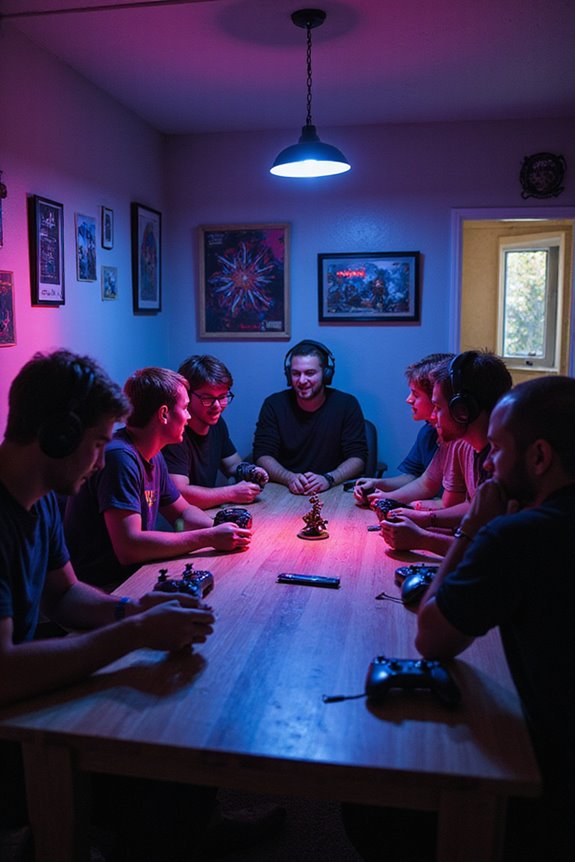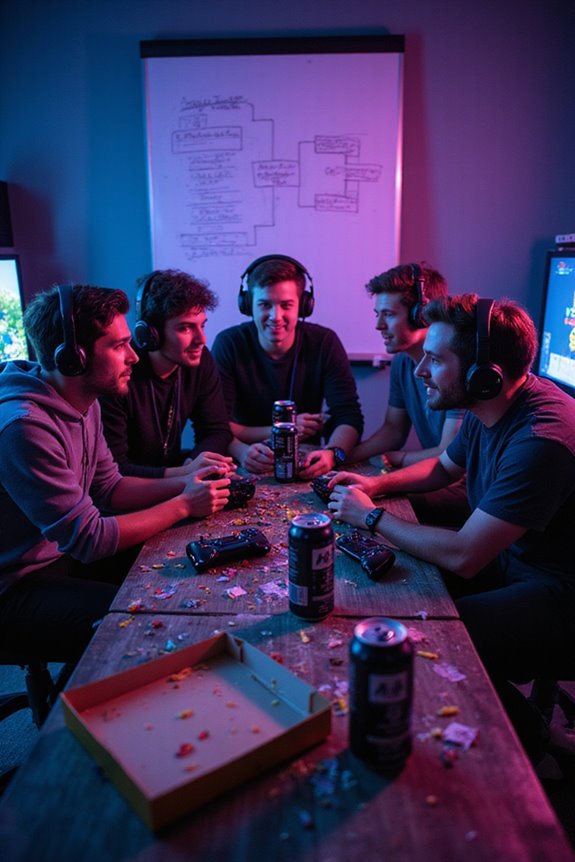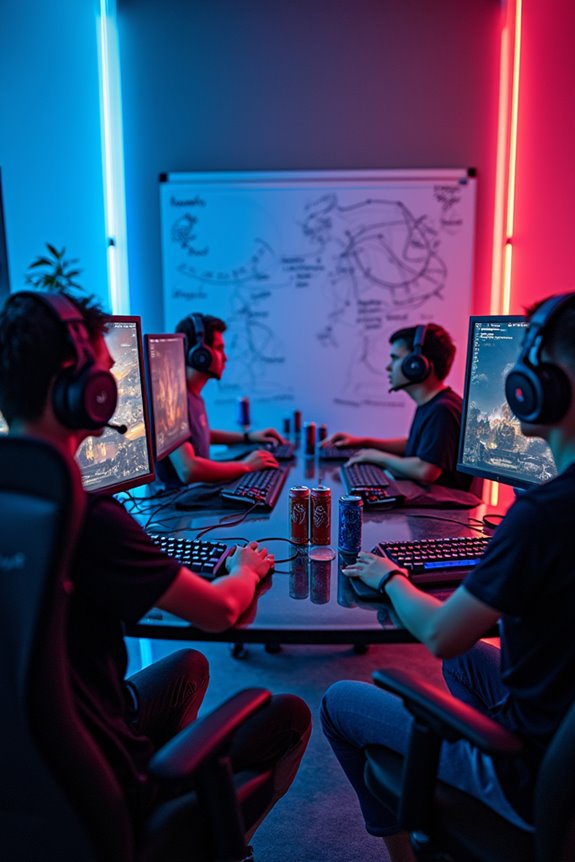Forging vibrant gaming communities starts with knowing your audience. I’ve found it’s essential to tailor experiences for different demographics, like Gen Z’s love for mobile games or Millennials’ preference for immersive ones. Leveraging social connections through multiplayer games fosters teamwork and friendships. Integrating user-generated content keeps things fresh and exciting. And don’t forget about inclusivity—diverse storylines resonate more broadly. If you’re curious about strategies to boost community growth, there’s a lot more to explore!
Key Takeaways
- Identify and understand your target audience’s preferences to tailor gaming experiences that resonate with them.
- Foster social connections through multiplayer games and community events to enhance player interaction and teamwork.
- Incorporate user-generated content and regular tournaments to maintain excitement and engagement within the community.
- Promote inclusivity by creating diverse characters and storylines that reflect the varied backgrounds of players.
- Establish open feedback loops to make community members feel valued and involved in shaping their gaming environment.
Understanding the Gaming Landscape
In today’s gaming landscape, understanding market trends is essential for anyone involved in the industry. I’ve noticed the global games market revenue dropped to $177.9 billion in early 2025, a slight decline but still significant. It’s projected to grow by 4.6% this year, reflecting inflation. Curiously, PC and console revenues are down, indicating a shift toward premium games amidst oversaturation. With around 3.32 billion active gamers worldwide, it’s clear that engagement is evolving. The US, while only 6.4% of global gamers, generates a hefty 26% of revenue. So, whether you’re a developer or a player, keeping an eye on these trends can help you navigate the ever-changing terrain. Let’s embrace this journey together! Additionally, it’s important to consider the impact on battery life when choosing mobile gaming accessories, as it can affect your overall gaming experience.
Identifying Your Target Audience

Identifying your target audience is essential for crafting engaging gaming experiences, especially since different demographics have unique preferences and behaviors. For instance, Gen Z thrives on mobile gaming and esports, while Millennials often seek immersive PC or console adventures. Notably, nearly half of all gamers are women, bridging the gender gap and enriching the community.
Comprehending these nuances allows us to tailor our gaming offerings effectively. Older players may appreciate nostalgic titles, while younger audiences are drawn to user-generated content. Recognizing these distinctions helps us create games that resonate deeply. So, consider who you want to reach, and remember, engaging your audience means speaking their language. After all, the more we grasp them, the more vibrant our gaming communities become.
Leveraging Social Connections in Gaming

Gaming isn’t just about solo adventures anymore; it’s become a vibrant social hub where connections flourish. The beauty of online gaming lies in its ability to foster informal relationships that can provide essential social support, especially for those lacking solid real-life connections. Multiplayer games, with their collaborative gameplay, encourage teamwork and communication, which strengthens bonds among players. I’ve often found that discussing life’s ups and downs with online peers can be surprisingly comforting. With the rise of social features in games and mobile gaming accessibility, the potential for meaningful interactions is immense. While challenges like harassment persist, creating inclusive communities can help cultivate a safe environment for everyone. Ultimately, gaming is about shared experiences and friendships that can enrich our lives.
Creating Engaging Content and Experiences

While creating engaging content and experiences is essential for building a vibrant gaming community, it can be a balancing act. I’ve found that incorporating user-generated content resonates deeply, as 79% of young players appreciate it. Regular events, like tournaments or challenges, keep excitement alive and encourage participation, ideally from 10% of our members. Maintaining open feedback loops is vital, too; it makes everyone feel valued and heard. Live streaming is a fantastic way to connect, drawing in large audiences and fostering a sense of togetherness. I also believe in the power of collaborative play—multiplayer games really enhance social interactions. By blending these elements, we can create a community that thrives on engagement and connection. Additionally, programmable buttons and axes on gaming peripherals provide enhanced control and customization for various gaming scenarios, contributing to a more immersive and personalized experience.
Utilizing Technology for Community Growth

As we embrace the potential of technology, it’s fascinating to see how it can really amplify community growth in the gaming world. Take cloud gaming, for example; it opens up high-quality experiences without demanding powerful hardware, making it easier to connect. Meanwhile, AI and machine learning personalize gameplay, adapting challenges to keep us engaged.
And let’s not overlook virtual and augmented reality, which create immersive worlds that deepen our interactions. Social media integration allows us to share moments and strategies effortlessly, strengthening our community bonds. Plus, cross-platform compatibility means we can unite players across different systems, expanding our reach. With all these tools at our fingertips, the possibilities for creating vibrant gaming communities are endless.
Encouraging Inclusivity and Diversity
Inclusivity and diversity aren’t just buzzwords; they’re essential ingredients for fostering a thriving gaming community. Nearly half of gamers are women, yet many games still rely on traditional character archetypes. By promoting inclusive storylines, we can resonate with broader audiences, allowing players to see themselves reflected in the narratives.
The diverse backgrounds of gamers enrich our community’s cultural fabric, making it more vibrant. However, the industry still struggles with leadership representation, primarily dominated by white developers. Initiatives like Black Girl Gamers create safe spaces, helping underrepresented groups feel supported. It’s imperative that we actively seek feedback from diverse members to improve our environments. Together, we can cultivate a community that truly welcomes everyone.
Measuring Community Success and Growth
How do we perceive if a gaming community is truly thriving? First, we look at the Community Participation Rate (CPR); ideally, at least 10% of members should be actively engaged. Audience growth is vital, too—more new faces mean more vibrant discussions. I also track metrics like message volume and event participation, as these reveal how lively our interactions are. Retention rates matter greatly; if new members stick around, it’s a sign of effective management. Don’t forget social media integration—platforms like Discord offer deep insights into our engagement levels. Finally, feedback mechanisms are essential; they help us adapt and improve. All these elements together create a clearer picture of our community’s health and success.
Frequently Asked Questions
What Are the Best Platforms for Building Gaming Communities?
You’d think the best platforms for gaming communities are all about flashy graphics. But honestly, I find Discord’s real-time chats and Reddit’s engaging threads create the most genuine connections. It’s where real friendships spark, right?
How Can I Attract New Members to My Gaming Community?
To attract new members to my gaming community, I focus on creating engaging experiences, leveraging social media, and fostering a welcoming atmosphere. It’s all about connection, and I want everyone to feel valued and included.
What Role Do Influencers Play in Community Engagement?
Isn’t it fascinating how influencers weave connections? They spark engagement by sharing experiences, hosting events, and listening to feedback, creating a warm space where we, as gamers, can thrive and grow together.
How Can I Manage Conflicts Within My Gaming Community?
Managing conflicts in my gaming community starts with open communication and clear roles. I prioritize active listening, swift intervention, and fostering respect, ensuring everyone feels valued and engaged. It’s all about creating a positive environment together.
What Metrics Should I Track for Community Health?
I’ve found tracking member logins, post activity, and response rates reveals a lot about community health. It’s amazing how these metrics can show our connections and help us feel more engaged and supported together.





